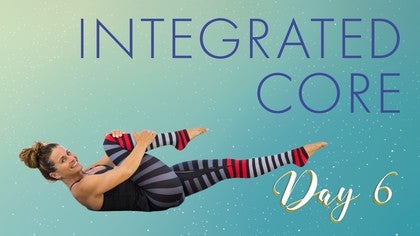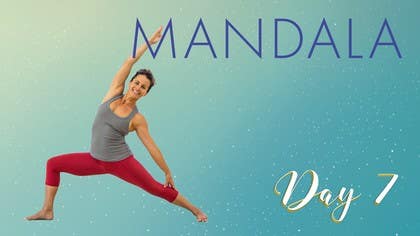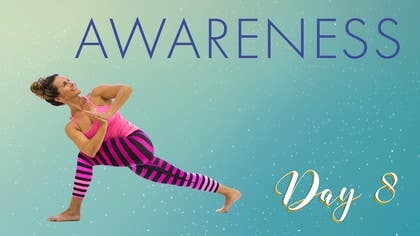Description
About This Video
Transcript
Read Full Transcript
Greetings tribe. Namaste. Welcome to day six. This practice is primarily grounded and explores the refined subtleties of working with your core and the tilt of your pelvis. So if you have a block handy, that'll be helpful.
If not, no worries. And come onto your back to start. And let's bend our knees and place our feet flat on the mat and just open up your arms out to the side. It's almost a baby shavasana to start. Close your eyes here and take a deep breath in and feel your chest and your rib cage wide and expanded.
And then as you exhale, just soften the chest and rib cage down and feel your navel center draw in and do that again, nice and wide to the ribs, full to the chest and exhale. Draw the navel in and soften through the chest and ribs and we'll start to add a little movement of the pelvis here. So as you inhale, arch your back and lift your waist. And then as you exhale, press the small of the back down into the mat and tuck the pelvis under and we'll just start to go back and forth on the breath, inhaling, rock and lift the waist and exhale, draw the tailbone under. And as you do this, there's some really kind of specific vocabulary we can use to make it simple.
If we're speaking anatomically, as you tilt back and forth, when you arch your back, we call this an anterior tilt of the pelvis. And when you press the small of the back into the floor and tuck the tailbone under, we call this a posterior tilt of the pelvis. And so as you move back and forth, just visualize the top of your hips, almost like a soup bowl that can pour forward or pour back. Pour forward anterior to the front of the body and pour back posterior to the back of the body. And as you move here, it's a nice little massage on the low back and on the hips, but it also will really inform our core work and a lot of our standing postures in a way that'll really help your structure.
So moving back and forth just a couple more times here. Some teachers like to call it a cat tilt or a dog tilt, right? So when we go to that rounded back, that's a cat tilt, and when we arch our back, that's a dog tilt. But just to keep it simple, we'll stay with anterior and posterior. So this time, lift your hips all the way up into a bridge pose and let's slide our arms down alongside our hips.
And then as you exhale, roll down from your heart, your ribs, your waist, your sacrum, and reach your arms over your head. Exhale, coil the tailbone under through that posterior tilt and roll back up through your bridge and then roll right back down, back of the heart, ribs, waist, sacrum, and inhale, reach over your head. All the way through the anterior tilt, back through the posterior tilt as you lift. And if this sounds too technical, don't worry about it. Just let it pass over you and wash over you and whatever sticks, sticks.
So let's roll up and down a couple more times. And just feeling how your spine is meant to move sequentially. That's why we have so many different joints in our spine through the vertebra. And so just articulating, moving like a string of pearls up and down, feeling into your back core as well as your front core. And one more time as you roll up, this time we'll stay lifted.
And even though we're technically in a back bend, there's an arch to the front of the body, try to coil the pelvis slightly under towards the posterior tilt and you'll feel some opening through the hip flexors and quads. Let's lace the fingers behind the back and walk your outer shoulders in underneath you and really open up across your chest, feeling fully into your bridge pose here. Couple deep breaths. And now you can really feel your back core working, the whole back of the body lifting up to stretch into the front body. Let's bring the feet a little closer together and take your right leg up to the sky and just spread your toes.
You can flex and point, roll through the ankle here. It's a little bit of work involved, no big deal though. Take a full breath in and then exhale. Set the right foot down, pressing into the sole of the right foot as you lift your left leg up to the sky and feel into the toes and the ankle of your left foot. Press down through the right foot, lift up a little higher and then set your left foot down.
Let's take the feet kind of wide, still parallel through the feet. And then as you start to roll down, separate your hands, your arms and let your spine just roll down as your arms come around your own chest and shoulders like you're giving yourself a hug. With your feet wide, let your knees knock together and just relax here. Take a deep breath in. As you exhale, soften through the shoulders and we'll just start to windshield wiper our knees from one side to the other, feeling into the outer edge of one foot and the inner edge of the other.
And as you do this, you can take your hands down to your hips and now feel how your pelvis is moving kind of asymmetrically. And this is a really wonderful way to open up the hips and the low back, super therapeutic to the inner hips. And so just enjoy that as you shift side to side. We're about to go into some core work here and then come back to the center and let's bring our feet together and our hands right underneath our hips. So you'll frame your sacrum with your hands.
And when we do this, it helps us just slightly tilt the pelvis towards posterior. That way when we lift our legs up, the weight of our legs can sometimes pull, lower your legs down. It'll pull your back into an arch, but we want to keep our tailbone slightly tucked under as our legs lift and lower. So really draw the navel center in a little, we call it udiyana bandha, it's one of our internal locks we work with, just simply drawing the navel in and up. And then as you lower your legs, can you keep your pelvis slightly tilted towards posterior and then bring it back up.
Let's inhale as we lower and exhale to bring it back up. And just notice what happens to the rest of your body as you lower your legs, do your shoulders pike up, do you arch your back and just try to keep the torso nice and quiet and relaxed, just the lower part of the core working as you lower and lift your legs. So let's take about four more, inhale to lower, a little bit of a posterior tilt in the pelvis. Exhale to bring it up. As you lower, can you keep the small of your back pressing against the floor?
Bring it up. Two more, lower it down, try to keep the small of the back pressing against the floor. Bring it up one more time, lower down, and then bring it back up. Draw your knees into your chest, give yourself a little bear hug here. So from here, take your legs back up to the sky, lower them back down where we were, but this time scoop up and draw your navel center in and now we're in a half boat pose.
So think of almost like a canoe or a banana shape and don't let your back arch, try to keep that posterior tilt to the pelvis, really fire up through your core and just feel this kind of low half boat shape, super powerful. And then from here, right knee draws in and start to just pump your legs like pistons. So we worked with this little rhythm yesterday and you can feel into this again as you breathe just for a few. And the next time your right knee comes in, just go ahead and hold it in. If your neck feels fatigued at all, you're walking to put your head down or just support the back of your head with your hand.
But let's keep the right knee in, keep that coiling of the pelvis and now lift and lower the long leg. And one of my favorite numbers is seven. So we'll do it seven times, that's three because it's a little more than five, but it's not as much as 10. It's kind of, it's right in the middle, six and one more, seven. Lift that leg lower all the way down and reach your right leg up, flex your foot.
We'll bring a little bit of Supta Padagusthasana back into the flow here, but let's keep it dynamic. So open your arms wide and then just rock back and forth between C and B. We did this standing yesterday and just feel how your core can facilitate and navigate this movement. Really try to keep your leg nice and straight and your breath involved. So we'll exhale into the twist and then we'll inhale up and over to open it. Exhale into the twist, inhale up and over, exhale all the way into the twist and pause.
If you can, grab onto that foot or take a strap if you have a towel, anything handy. You can even bend your knee, but hold onto something there and then bend your bottom knee and let's see about grabbing that bottom foot. Open it, you kind of might be like, where is that foot? Is it on someone else's body? Where is it?
But if you can grab it, do so and just relax into a twist here with a quadricep opener. It's a really cool posture. There's so much opening happening in the spine, the hip, hamstring, quadricep, even your neck. So do what you can here. Super therapeutic even if you're not holding that bottom foot.
And just one more full breath. Exhale completely. And then let's let the bottom foot go first. Top knee bends, come back to center and coil up. Both knees come in, let's bring it from the top.
So legs straight up to the sky, support your pelvis, and then let's lower and lift our legs with your head either lifted this time or you can bring it back down. It's up to you. So I kind of like to do this with my head down so I can really just focus on the position of my pelvis. So keeping that posterior tilt, let's slow it down a bit for these next three. Working with some refinements, some subtleties, and how you move through your body.
Building strength as we do so, lowering the legs, lift it back up, try to keep the small of your back pressed into the floor, lower down and hold, and then let your hands go and scoop up into your half navasana. Pull in through the belly, keep that coil of the pelvis towards the posterior tilt. It's really hard. And then left knee comes in and let's pump the legs in and out seven times. Breathing deeply.
Exhale. Just building a little strength and stamina through the front core as well as the back core. We'll get to the back core at the end of this practice. Next time that left knee comes in, hover and then just lift and lower through the long leg. Exhale.
Inhale. Exhale. Again, if your neck's feeling tired, just put your head down or support it with your hand. Totally up to you. One more cycle and lower all the way down.
Take the left leg to the sky, open up your wings. Let's cross it over and then open it up. And just using your own core, your sideways to move in a way that is supported. You're not rushing, right? Moving with a bit of control.
No need to rush. Exhaling as you twist. Exhaling as you come open. Exhaling as you twist. Inhaling.
Last cycle. Bring it all the way over. Grab onto something. Your foot, your knee, pant leg, something. And then see about that bottom leg.
Maybe lift your head. There it is. And relax down towards the floor. You can feel how this posture is like a first cousin to Supta Padagastasana C, to the standing Padagastasana C. All right.
And the more that you can relax towards the floor, the better. A couple breaths here. And as you're ready, release the bottom foot first. Half knee second. Come back to the center and hug your knees into your chest.
So last little bit on our back here before we come up to standing and put some things into play is to grab your block. You can also use a rolled up towel or a pillow and just place it right between your knees and give it a good squeeze. Whenever we lift our legs up off the floor, again, that reminder that it can pull your pelvis towards an anterior toe. But we want to try to keep the low back glued to the mat, feet lifted and squeeze into the block so that you get into your pelvic floor. That's also part of our core.
Yogis like to call it your mula bandha, it's the pelvic floor. So squeeze into the block and then let's take the knees over to the left and then exhale back to the center, over to the right and back to the center. Again, as you twist, keep going careful that you don't lower the femur bones and arch your back. We want to try to just roll right across the waist. Keep the feet lifted, the knees lifted and squeeze the heck out of that block.
Now this is a really therapeutic little Creole exercise to work with with bent knees. If you'd like a little more, you can straighten your legs just like we did in our dynamic Padagusthasana B and C, but you want to move your legs almost like they're moving along a wall in front of you. So don't let them lower away from you. Try to keep that kind of right angle, vertical plane as you move side to side. And I know it's a lot of technical information, but bear with me and just receive it.
Let it kind of flow in and stick wherever it's going to stick. A couple more each side, inhaling to the center, exhaling to the twist, inhaling center, exhaling to the twist, and then come all the way back. Bend your knees and set your block to one side. Let's rock on up to our floating child's pose, AKA Navasana, and you can stay right here and just relax into a rounded spine. If you're feeling energetic, feel the front core and the back core lift and then start to lift your legs, experimenting with a full Navasana today, reaching long through the legs, up through the heart, up through the corners of your mouth, and then cross your ankles and let's come up to standing.
Just spin into your forward fold and relax your spine here. So in your forward fold, since we've been kind of feeling into all this pelvic tilt shenanigans, see if you can soften the knees a little bit and feel an anterior tilt of the pelvis so that top of the suit bowl is pouring forward. You can keep the knees bent or start to straighten your legs, but feel that lift of the sits bones and that tilt of the pelvis forward. It's inside of every forward fold. Let's enjoy a couple of breaths here.
One more breath and then as you lift your heart, come up under your fingertips and walk your hands forward into downward facing dog and it's just one standing posture today, just one. So let's really enjoy it. Take the right leg to the sky on a nice big inhale, paint the sky with your toes, exhale draw the need of the navel step all the way through to a runner's lunge. You can widen the stance slightly and when you come up to your crescent pose, let's bring our hands to the hips and just feel into the ability to tilt your pelvis here. And so for many of us that maybe have a little tightness in our hip flexors and our low back, our pelvis kind of tends to sit forward and we come up into our lunge and we go, why does my back hurt?
So if you feel like that's how your posture is, you might try just slightly navigating your pelvis, top of the suit bolt towards a posterior tilt. We're not going to be completely tilted under, but it's just a slight tilt and you'll feel some action in the hip flexor of the left leg. So tailbone down, front of the hips slightly up and then reach upward into your crescent pose and just feel into how integrated this shape is now. Just take a full breath in. As you exhale, bend your elbows and open your arms like a cactus and we'll just take a few movements here, inhale, reach up, exhale, bend the elbows, keep dropping the tailbone down, inhale, reach up, exhale, open and then release your hands down, step back to downward facing dog and we'll go right into the second side.
Left leg rising on an inhale, really enjoy it, exhale, step all the way through and coming up into your runner's lunge crescent pose on the second side and just feel into what your hips are doing in pretty much every standing pose. We have this opportunity to work with the tilt of our pelvis. So if we're sitting into the low back, it can be really empowering to transfer that power down into your legs, tailbone drops down, front of the pelvis lifts. See if you can keep that action in your pelvis and then reach forward and up as you inhale, exhale, bend the elbows, open the chest, inhale, reach up, exhale, bend the elbows. Once more, inhale, reach up, exhale, open up through the chest, bring your hands down and then step back to your downward facing dog.
Let's roll forward to plank, feel how the pelvis coils under and then as you exhale and press back to down dog, feel how it tilts upward. So we roll to plank, pelvis feels like it's moving towards a posterior tilt and when we lift to down dog, your pelvis feels like it's tilting anterior. Take that three more cycles and just feel how your hips can kind of lead the path here. Exhale, lifting the sit bones, tilting back. Once more, this time as you travel all the way forward towards plank, let's explore upward dog.
Keep your toes tucked under, but just let your hips melt down, the quads stay lifted and the heart open. So we're an upward dog, on the balls of our feet, what? And then we'll come down, it's almost like an inverse vinyasa, so keep the heart open, just bend the elbows and feel your thighs plant, your hips, your navel, your ribs, your heart, forehead touches, feet relax, yay, bend your knees, stack your hands into your forehead and just windshield wiper your knees side to side. And feel that asymmetrical tilt of your hips, your pelvis, and now we're free to move into a little awareness of our back core. And why do we need to do this?
Why do we need to focus on strengthening and supporting our core? It supports our spine, the center of our body, right, all of our postures, our movement, our ability to be an upright human being comes from that center integrated strength of our body. So from here, stretch your legs long and turn the center of the thighs down towards the earth, tops of the feet are flat, and then just reach your arms back behind you so your palms are facing down. Let's inhale to lift the chest, press down through the palms and then lift your thighs coming into locus pose and here again, keep talking about the tilt of the pelvis. Feel your tailbone dialed down towards the heels as your heart lifts up and reach long through your legs.
Your arms can lift, feel the whole back body engage and let's enjoy a few breaths here. Neck is relaxed, make sure you're not over flexing at the neck. And then as you inhale, slowly reach your arms all the way forward, arms and legs are just an inch or two off the mat and then exhale, release it down. Bend your elbows, lift up into sphinx pose for a moment and center your elbows right underneath your shoulders, lift up through your chest and pull your heart forward. Reach back through your legs, take a full breath in here.
As you exhale, spin the elbows wide and lower down, ribcage, heart, forehead, bend your knees, windshield wiper a little bit side to side and then come back to center and let's lift up and reach back for our feet coming into Dhanurasana. If you can't reach your feet, no big deal, you can reach for them but keep a little space. If you can, hold on and as we inhale and lift up, we'll lift our chest, our thighs and our spirits and just feel how the back body is strengthening the back core and the front body is opening, shoulders relaxed, chest open. Let's enjoy a few breaths here and tailbone, you guessed it, is reaching towards the back of the mat. One more full breath.
Just slowly release. Hands into the forehead, windshield wiper your knees and just as a little counter pose for that back bend, go ahead and extend long through the left arm and left leg, left arm straight out to the side. Keep the right knee bent, right elbow bent and then just roll onto your left side and you can let your head relax down against the floor if you still have your block handy or pillow handy then you can give yourself a nice little head rest right here as you relax into the twist. And if this is compressing the small of your back at all, just feel into that slight tilt towards posterior ever so slightly and notice if that creates a little length in your lumbar spine. Sometimes it's the smallest adjustment that can make all the difference.
From here let's slowly roll back through center. We'll go to second side so the right arm, the right leg is long, might adjust your block over, bend the left knee, left elbow and roll onto your side. Just hang out here and notice how it feels in your body and it's a nice little stretch in the bottom shoulder and chest. This feeling of grounding down, of listening to the earth, you can close your eyes, listen to your breath, listen for that simple intention or dedication. Can be different every day or it can be the same one.
Slowly come back to the center and set your block to one side once again and to come out of this we'll come back through sphinx pose, elbows right under the shoulders, palms are flat, curl your toes under and lift up to your forearm plank and feel that gathering into the front core, into the pelvic floor, engaging through the inner thighs, relax through the face here and just take a moment or two to feel your integration in the front body. Sometimes I like to rock on the toes a bit. From here let's walk the feet in introducing one more new shape, this is called dolphin pose, just like downward dog but on your forearms and reach your chest back, feel this really nice opening through the shoulders, through the upper back and pelvis is moving towards an anterior toe, lift the sitz bones. Relaxing here for a couple of breaths, there's a little work in the shoulders and as you exhale lower the knees down and let's come into child's pose. Take a deep breath here, noticing how your breath can spread out into the back ribs, the back of the heart and the low back and exhale completely.
Draw your hands in towards your knees and roll up your spine, if it's comfortable to sit in this position, Virasana, just take a moment here sitting tall, we're about to come to our backs into Shavasana but just take a moment and center yourself with your breath and as you're ready you can slowly spin around and roll down onto your back, extend your legs long on the floor and separate your feet wide and then open up through the palms, take a deep breath in here, exhale through the mouth, exhale all the breath out and then allow your breath to return to a natural easy soft rhythm, close your eyes and rest. Good. Start to deepen your breath and send a little movement to your fingers and your toes. Taking your left hand to your heart, your right hand to your belly and breathing into those two intuitive centers. And exhale through the mouth.
And reach your arms over your head, reach through the fingers, the toes. Exhale, draw the knees into the chest. Roll on over to one side and come on up to a comfortable seated position. Yay. Draw the hands together at your heart, sitting tall.
Thank you so much for joining me today, for sharing your presence and your practice and your enthusiasm. I look forward to seeing you down the path in the next practice. Namaste. Have a great day.
Awaken to You: 30-Day Yoga Challenge
Comments
You need to be a subscriber to post a comment.
Please Log In or Create an Account to start your free trial.























